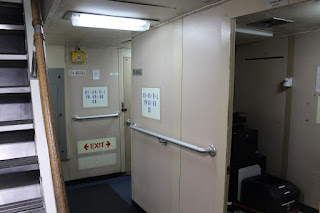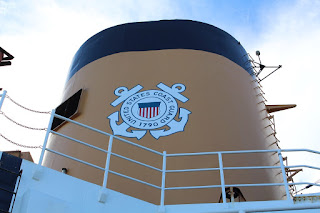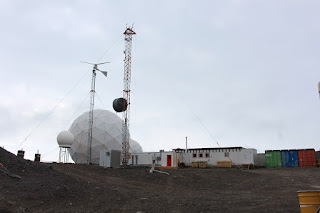Icebreaker Time
Current weather: 23F Mostly sunny light winds.
It is the US Coast Guard Polar Star. A 399' 13,000 ton heavy ice breaker. Here it is breaking in McMurdo Sound with the Royal Society mountain range in the background.
And another shot of them breaking the turning basin just outside of town. In the foreground is the wastewater treatment plant.
So, as is customary, when the Polar Star comes into Winterquarters Bay, they pushed the Ice Pier, This year they pushed the pier so far against the ground that all of the ice that was between the pier and the wharf pushed upwards and lifted the Bailey Bridge off its base. From this view you can see how high up they jacked it. The photo looks like the excavator is lifting the bridge, but it is not. That is sea ice holding it up. Oops.
And here is Fleet Ops using the Grove Crane and many other pieces to get the bridge back down where it belongs.
So, we got a tour of the Polar Star after they docked on the pier.
In the foreground on this photo you can see the containers that have been prestaged on the wharf. They are loaded with waste headed back to the US.
Here is the Tower of Power. The heart of the ship offload season. This tower is the traffic control point for all of the wharf area.
Now on to the ship. Walking up the gang plank.
And a cool view of a huge ship from ground level.
This is the bridge. It extends from beam to beam so that they can watch the ice over the sides of the ship.
Here is a view of some of the shinny new computer like stuff.
And here is some of the not so new communications stuff.
A cool photo of the tall part of the ship. I am sure that there is a name for it, but I call it the tall part.
A view from the deck above the bridge. Looking at the shore of Winterquaters Bay and up into town.
If you have to use this boat, you are having a bad day. I guess this is more of a support boat than a life boat, but it still doesn't sound like fun in icy waters.
A view of the Bailey bridge from above the bridge. More tour goers walking across.
Here you can see the plank. Also there is a fuel line on the wharf. The ship took on between 400,00 and 500,000 gallons of JP-5 fuel. To give you an idea, the South Pole Station takes between 300,000 and 400,000 gallons for a year.
I liked this on the bridge. They obviously don't care about local time.
A view going down some of the interior stairs.
Just some random interior hallway views.
Hey look, more hallways.
This is some of the modern control systems that are on wall.
And the customary bronze plaque.
A view of the Galley. And I looked, I couldn't find a Pepsi machine anywhere on the ship this season. Unfortunately.
Look, really big ice chunks.
Big ice chunks and the corner of the Ice pier.
A nice view of the CG symbol.
You know that you are in a '70's vintage anything when there are asbestos warning plaques posted.
So last week this thing arrived.
It is the US Coast Guard Polar Star. A 399' 13,000 ton heavy ice breaker. Here it is breaking in McMurdo Sound with the Royal Society mountain range in the background.
And another shot of them breaking the turning basin just outside of town. In the foreground is the wastewater treatment plant.
So, as is customary, when the Polar Star comes into Winterquarters Bay, they pushed the Ice Pier, This year they pushed the pier so far against the ground that all of the ice that was between the pier and the wharf pushed upwards and lifted the Bailey Bridge off its base. From this view you can see how high up they jacked it. The photo looks like the excavator is lifting the bridge, but it is not. That is sea ice holding it up. Oops.
And here is Fleet Ops using the Grove Crane and many other pieces to get the bridge back down where it belongs.
So, we got a tour of the Polar Star after they docked on the pier.
In the foreground on this photo you can see the containers that have been prestaged on the wharf. They are loaded with waste headed back to the US.
Here is the Tower of Power. The heart of the ship offload season. This tower is the traffic control point for all of the wharf area.
Now on to the ship. Walking up the gang plank.
And a cool view of a huge ship from ground level.
This is the bridge. It extends from beam to beam so that they can watch the ice over the sides of the ship.
Here is a view of some of the shinny new computer like stuff.
And here is some of the not so new communications stuff.
A cool photo of the tall part of the ship. I am sure that there is a name for it, but I call it the tall part.
A view from the deck above the bridge. Looking at the shore of Winterquaters Bay and up into town.
If you have to use this boat, you are having a bad day. I guess this is more of a support boat than a life boat, but it still doesn't sound like fun in icy waters.
A view of the Bailey bridge from above the bridge. More tour goers walking across.
Here you can see the plank. Also there is a fuel line on the wharf. The ship took on between 400,00 and 500,000 gallons of JP-5 fuel. To give you an idea, the South Pole Station takes between 300,000 and 400,000 gallons for a year.
I liked this on the bridge. They obviously don't care about local time.
A view going down some of the interior stairs.
Just some random interior hallway views.
Hey look, more hallways.
This is some of the modern control systems that are on wall.
And the customary bronze plaque.
A view of the Galley. And I looked, I couldn't find a Pepsi machine anywhere on the ship this season. Unfortunately.
Look, really big ice chunks.
Big ice chunks and the corner of the Ice pier.
A nice view of the CG symbol.
You know that you are in a '70's vintage anything when there are asbestos warning plaques posted.
And that is it. Headed back home. You can see our dormitory in the background. Cool to see the ship up close again. Shortly after this tour we got a tour of the USAP research vessel the Nathaniel B. Palmer. I should have some photos of that up soon.
Currently the cargo ship has been tied up to the pier for 3 days. They are pretty much done with the offload, and the backload of waste has begun. I have been working on shift for the last week or so to fill in for a co-worker that is out with an injury. So I have been working as a shift Lt. on A shift with Paula. I have been working 24 hours on and 24 hours off nominally. And I have been filling in keeping up with my Inspecting duties as well. So I have been keeping busy for a while now. I will be going back to my day schedule sometime this week.
That is all for now. More to come.
R.J.





















































